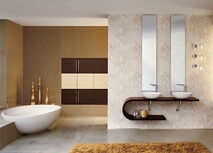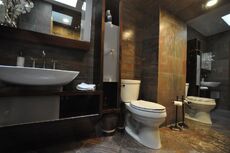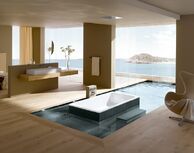This week we chose which group presentation topic we would be doing. We chose to do the Intellectual Property topic, as it's quite relevant to our project, given the amount of IP we are both using and creating. Thankfully we have a number of weeks to prepare for this presentation, which is useful in order to determine exactly what role IP plays in our project and why it's important.
There is also another group doing IP, since there are 6 groups and 5 topics. It will be interesting to see how our presentations differ and what effect our differing projects have on our perception of the topic.
We discussed with Stephen Davey and Russell Lowe where our project should be headed and how much we can feasibly get done. This is one of the more difficult parts of the project, since it's very difficult to tell what kind of problems we'll come across, especially with the Kinect integration, Stephen Davey has some code already implemented, but it could take a single day or multiple years. With this in mind we'll need to continually re-evaluate what our end goal is as we progress through this project so we don't devote too much time to a single area and end up having an incomplete project or a project with a single, disconnected feature.
We also began discussing the kind of design we wanted to use to translate the Kinect around the room. Designs we are currently evaluating are a simple two-axis hinge system that could sit in the corner of the room and simply rotate side-to-side and up and down to keep the user in range, also a Spider-cam-like system that uses 4 wires on winches to move the Kinect across the roof of the room as well as a rotating motor to turn to face the user. Another possibility is a rail-based system that can move the Kinect along a rail on the roof, and potentially throughout the house.
Each of these designs will be evaluated in terms of its potential flexibility as well as ease of construction.
Tuesday, March 26, 2013
Wednesday, March 20, 2013
Week 3
Back Brief:
This week we presented the back-brief, which is essentially what we have decided to do for our project and what the component tasks need to be done to complete it.
All this information was posted on our wiki to provide a common area for our members to communicate. The wiki will be used to document progress and provide reference for each project member to ensure a cohesive project is delivered.
This week we presented the back-brief, which is essentially what we have decided to do for our project and what the component tasks need to be done to complete it.
Back Brief Outline
- Group Name: Geriambiance
- Group Members:
- Steven Best (leader)
- Dan Zhang (Dan)
- Jing Liu (Laura)
- Mathew Kruik
- Siyan Li (Allen)
- Group Project: Livable Bathrooms
Project Conditions
- Project Concept:
This project aims to create a series of smart and convenient bathroom appliances and fixtures, designed for ease of use for elderly people. A Kinect for Windows will be situated in a corner of a bathroom in order to track resident’s movement and body reactions, allowing it to adjust bathroom devices intelligently. The height and conditions of furniture and equipment can be controlled by residents’ gestures to help with their everyday bathroom activities which could be hindered by a lack of movement.
- Project Proposal:
In the project, a series of bathrooms will be designed and imported into CryEngine 3, a video game engine. This will be linked to a Microsoft Kinect for Windows, a motion tracking device, which allows a person to move around in a real world space and control the in game character. This allows a demonstration of how the Kinect allows the control of real world appliances and fixtures through gesture control.
- Specific Intelligent Equipment:
- Door:
- Open - When residents stand in front of and face the door, the door will automatically open.
- Close/lock - When residents enter the room, the door will automatically close and can lock with the use of a specific gesture.
- Light:
- Main light – open/close: When residents enter or leave the bathroom, the main lights will turn on or off accordingly
- Mirror light – open/close: When residents enter or leave the area occupied by the mirror, lights around the mirror turn on and off accordingly. Gesture control allows for the dimming and brightening of these lights.
- Shower light – open/close: When residents enter or leave the shower area, shower light will automatically turn on and turn off accordingly.
- Sink:
- Turn on – When users put their hands under the tap, the tap will turn on.
- Turn off – When users move their hands away, the tap will turn off.
- Up – When users lift up their palms, the water pressure increases.
- Down – When users move their hands down, the water pressure decreases.
- Shower:
- Tracking – When a resident turns the shower on, the Kinect knows where their body is in relation to the shower head, and will move the shower head to be in the right position for the body, both in height and sideways movement.
- Temperature:
- Up – When users lift up their palms in the shower, the water temperature increases.
- Down – When users move their hands down in the shower, the water temperature decreases.
- Toilet:
- Positioning – When a resident enters the bathroom, the Kinect reads their body height and adjusts the height of the toilet to best suit their needs for sitting down.
- Flushing – When residents stand up from the toilet, the toilet will start flush automatically.
- Ventilation:
- Turn on/off - When residents enter the space, the exhaust fan will turn on intelligently and when they are out of the space, the exhaust fan will turn off automatically.
- Safety
- Collapse Detection - The Kinect can detect when a user falls down and can alert relevant persons to assist.
- Door:
Project Planning
- Bathroom Design
- Designers: Dan Zhang (Dan), Jing Liu (Laura), Siyan Li (Allen)
- Design Proposal: Design a series of three bathrooms, containing all the devices to simulate a real world space. After modelling the bathrooms, this 3D space will be imported to CryEngine 3, where it will be hooked up to the Kinect. These bathrooms will encompass all of the fixtures and devices used by the elderly, including those that assist them with disabilities.
- Design Scales: 3x2m, 3x4m, 4x6m.
- Design Concepts:
Sink Design: Embeded in timber frame floor / Easy to adjust height
Toilet Design: Regular height / Within steel column to adjust height
Shower Area: Seperated by glass/ protect privacy
Bath Tub Design: Build in / Easy to get in for elders
- Programming
- Programmers: Steven Best, Matthew Kruik.
- Programming Concept:
- Connecting the Microsoft Kinect to a computer, the data is read by the node system in CryEngine 3, allowing full control of the character, and interaction with the virtual space.
- Additionally, an Arduino kit will be used to allow the Kinect system to track the user, negating it's small range and limited movement.
- Test Proposal:
- Outlining an area in a room that equates to our virtual space, the sensor is located in the same position it is in the game engine. A series of boxes are setup throughout the space, mimicking fixtures such as toilets and sink. A user is able to walk through the space and see onscreen how the virtual appliances and fixtures react to them.
- To take this one step further, we will look into virtual reality devices such as the Occulus Rift, which would allow a much more immersive experience.
All this information was posted on our wiki to provide a common area for our members to communicate. The wiki will be used to document progress and provide reference for each project member to ensure a cohesive project is delivered.
Monday, March 11, 2013
Week 2
Group Allocations:
This week we where allocated into our groups for the upcoming projects. Oddly, the CV assignment was not used and instead the group leaders where simply those with the highest WAM, and students with lower WAMs could choose which group to join.
While this meant that each group had a common interest in the project, it also meant that the proposed diversity of skills was less organised and more luck-based depending on who was interested in the project.
The group I joined is comprised of:
Team Roles:
Once we where in our group, we decided to split into to main teams, the programming/Kinect team consisting of Steven and myself, and a modelling and design team consisting of Laura,Dan, and Siyan.
It was also decided that, given his previous experience, Steven would be the group leader.
Project:
We are looking at the Liveable Bathrooms project and are hoping to create a system to track people in bathrooms using the Kinect sensor and using Cryengine to simulate potential interactive elements.
We will further refine this project plan in preparation for the back-brief presentation next week.
This week we where allocated into our groups for the upcoming projects. Oddly, the CV assignment was not used and instead the group leaders where simply those with the highest WAM, and students with lower WAMs could choose which group to join.
While this meant that each group had a common interest in the project, it also meant that the proposed diversity of skills was less organised and more luck-based depending on who was interested in the project.
The group I joined is comprised of:
- Matthew Kruik
- Steven Best
- Laura Liu
- Dan Zhang
- Siyan Li
Our group is doing the Liveable Bathrooms project.
Team Roles:
Once we where in our group, we decided to split into to main teams, the programming/Kinect team consisting of Steven and myself, and a modelling and design team consisting of Laura,Dan, and Siyan.
It was also decided that, given his previous experience, Steven would be the group leader.
Project:
We are looking at the Liveable Bathrooms project and are hoping to create a system to track people in bathrooms using the Kinect sensor and using Cryengine to simulate potential interactive elements.
We will further refine this project plan in preparation for the back-brief presentation next week.
Subscribe to:
Posts (Atom)



